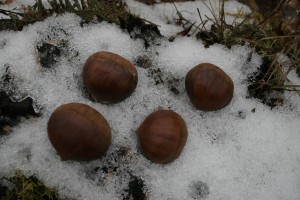Tragedy at Sandy Hook: It’s time to take action against assault rifles
I had to take a short walk this morning before putting any thoughts on paper. The Chickadees were already taking seeds from the feeder and the Turkeys were calling from their roost as it was about time for them to come down and eat.
I took a look at the rub a buck left on one of my trees a couple weeks ago. An icy rain was falling.
I have to reflect on the tragedy at Sandy Hook Elementary School of last Friday as it still brings tears to my eyes.
Karen and I were shopping in Utica and heard the news when we stopped at Pumpernickel’s for lunch.
The details came across the TV screen: several small children and teachers had been killed at the Newtown, CT school.
The scope of the tragedy unfolded as we ate. Twenty children ages 6 to 7 years old and the six teachers who were trying to protect them had been killed.
The assailant had taken his own life.
How many times will this kind of a tragedy occur before some action is taken on assault rifles and gun clips for guns that hold multiple rounds of ammunition.
This has got to be the time for change, no matter what the NRA fights it with.
I gave up my NRA membership five years ago and it wasn’t until a year ago that they finally stopped sending me applications.
I am a hunter and a sportsman, but there is no need for assault rifles or clips holding more than five rounds for any guns used in the hunting world.
All it takes is one good shot to take down any type of game when hunting.
If this tragedy doesn’t change some minds I don’t know what will.
I will still have my hunting guns, as will everyone else who uses them for that purpose.
I know there are enough of us in the hunting community who feel that the laws can be changed without our rights of using guns for hunting being affected.
I hope the politicians who have supported the NRA in the past will change their minds.
Some of those victims could have been their own children.
My thoughts and prayers go out to all those affected by this tragedy. It will take a long time for folks to heal from it, if they ever do. So much hurt caused in just a few short minutes.
On a lighter note, the Audubon Christmas Count was on Saturday (12/15).
I have to say my heart wasn’t in it, however I did get to take a couple walks in the woods.
Most of the birds were found at feeders as there is little wild food out in the woods.
There were several kinds of ducks and geese in the open water of the Fulton Chain which added to the count. (A total count of all the birds will appear in my next column.)
Another bright spot in the outdoor world is the possibility of regrowth of the American Chestnut tree that is tolerant to the fungus that notoriously killed most of them over a century ago.
This fungus started in America in 1904 and in a few years spread throughout the tree ranges from Georgia to Maine.
It killed most of the mature trees, but stump sprouts kept coming up from the roots.
The wood of the beautiful tree has a pretty grain and was used in making furniture, flooring and in building.
I’ve only seen a few mature American Chestnuts, one about eight inches on a stump near where I was brought up, and two large trees in the Holland Patent Cemetery.
Seeds from the Holland Patent trees were used in some of the early studies at SUNY College of Environmental Science and Forestry at Syracuse. After over 25 years of work Dr. Charles Maynard and Dr. William Powell have created a genetically altered American Chestnut that can withstand the fungus and the lethal acid it produces.
Ten of the new disease-resistant trees were planted April 10 of this year at the New York Botanical Gardens in the Bronx, where the disease was first discovered over 100 years ago.
A dead stub of a Chestnut—about ten feet tall— was the first time I ever saw one of the trees. It was across from our house and Bluebirds were nesting in it. Later, I found several stump sprouts some of which produced nuts.
I gathered the nuts and took them to the State Tree Nursery in Saratoga where they grew into small trees. However, when the trees reached about five years old they were killed by the fungus.
Then, in 1973 while on a search on French Mountain (south of Lake George) I found several stump sprouts scattered all over the mountain.
The nuts from the American Chestnut were a main food of the Passenger Pigeon. The consumption of the nuts could have led to some of the birds’ problems and ultimate extinction.
Today, the Chestnuts we roast over an open fire are Chinese Chestnuts. Hopefully in future years they will be from American Chestnuts. Audubon Christmas Count results but that’s another story. See ya.

